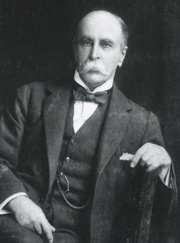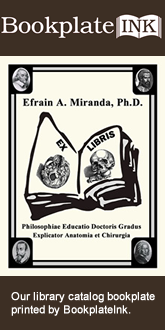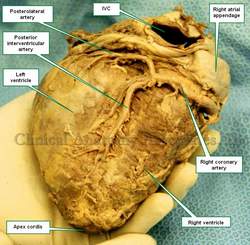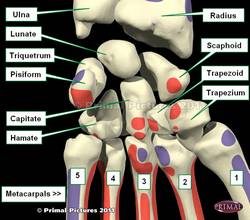
Medical Terminology Daily (MTD) is a blog sponsored by Clinical Anatomy Associates, Inc. as a service to the medical community. We post anatomical, medical or surgical terms, their meaning and usage, as well as biographical notes on anatomists, surgeons, and researchers through the ages. Be warned that some of the images used depict human anatomical specimens.
You are welcome to submit questions and suggestions using our "Contact Us" form. The information on this blog follows the terms on our "Privacy and Security Statement" and cannot be construed as medical guidance or instructions for treatment.
We have 398 guests online

Georg Eduard Von Rindfleisch
(1836 – 1908)
German pathologist and histologist of Bavarian nobility ancestry. Rindfleisch studied medicine in Würzburg, Berlin, and Heidelberg, earning his MD in 1859 with the thesis “De Vasorum Genesi” (on the generation of vessels) under the tutelage of Rudolf Virchow (1821 - 1902). He then continued as a assistant to Virchow in a newly founded institute in Berlin. He then moved to Breslau in 1861 as an assistant to Rudolf Heidenhain (1834–1897), becoming a professor of pathological anatomy. In 1865 he became full professor in Bonn and in 1874 in Würzburg, where a new pathological institute was built according to his design (completed in 1878), where he worked until his retirement in 1906.
He was the first to describe the inflammatory background of multiple sclerosis in 1863, when he noted that demyelinated lesions have in their center small vessels that are surrounded by a leukocyte inflammatory infiltrate.
After extensive investigations, he suspected an infectious origin of tuberculosis - even before Robert Koch's detection of the tuberculosis bacillus in 1892. Rindfleisch 's special achievement is the description of the morphologically conspicuous macrophages in typhoid inflammation. His distinction between myocardial infarction and myocarditis in 1890 is also of lasting importance.
Associated eponyms
"Rindfleisch's folds": Usually a single semilunar fold of the serous surface of the pericardium around the origin of the aorta. Also known as the plica semilunaris aortæ.
"Rindfleisch's cells": Historical (and obsolete) name for eosinophilic leukocytes.
Personal note: G. Rindfleisch’s book “Traité D' Histologie Pathologique” 2nd edition (1873) is now part of my library. This book was translated from German to French by Dr. Frédéric Gross (1844-1927) , Associate Professor of the Medicine Faculty in Nancy, France. The book is dedicated to Dr. Theodore Billroth (1829-1894), an important surgeon whose pioneering work on subtotal gastrectomies paved the way for today’s robotic bariatric surgery. Dr. Miranda.
Sources:
1. "Stedmans Medical Eponyms" Forbis, P.; Bartolucci, SL; 1998 Williams and Wilkins
2. "Rindfleisch, Georg Eduard von (bayerischer Adel?)" Deutsche Biographie
3. "The pathology of multiple sclerosis and its evolution" Lassmann H. (1999) Philos Trans R Soc Lond B Biol Sci. 354 (1390): 1635–40.
4. “Traité D' Histologie Pathologique” G.E.
Rindfleisch 2nd Ed (1873) Ballieres et Fils. Paris, Translated by F Gross
"Clinical Anatomy Associates, Inc., and the contributors of "Medical Terminology Daily" wish to thank all individuals who donate their bodies and tissues for the advancement of education and research”.
Click here for more information
- Details
The posterolateral artery, also known as the "retroventricular artery" is one of the two terminal branches of the right coronary artery. The other terminal branch is the posterior interventricular artery or PDA. This artery presents with many variations, from being absent to extremely long arteries with extensive branching that take some of the territory of the circumflex artery. The posterolateral artery extends from the crux cordis to the left side of the heart in the atrioventricular sulcus.
The AV node artery, which provides blood supply to the AV node (a component of the conduction system of the heart) may arise from the posterolateral artery instead of arising from the right coronary artery or the posterior interventricular artery.
When present, the posterolateral artery provides some posterior left ventricular branches and maybe some posterior left atrial branches. See the accompanying image, you may click on the image for more information. The image depicts a posterolateral artery slightly longer than usual.
Image property of: CAA, Inc. Photographer: E. Klein
- Details
This article is part of the series "A Moment in History" where we honor those who have contributed to the growth of medical knowledge in the areas of anatomy, medicine, surgery, and medical research.

Sir William Osler
Sir William Osler (1849-1919). William Osler was born in Bond Head, Canada, in what today is known as Ontario, of English parents. He started his college studies to become a minister, but realizing his true vocation was in medicine, he entered the Toronto School of Medicine, earning his medical degree in 1872.
Osler completed postgraduate studies in Europe, returning as a Professor at the McGill University. In 1884 he moved to Philadelphia to the University of Pennsylvania. In 1889 he left to become Physician-in-Chief and one of the founders of the newly-built John Hopkins hospital. His contributions to this new hospital and the American medical education are innumerable. Dr. Osler initiated the residency programs used today, as well as the programs of third and fourth year medical students in bedside patient rounds.
A prolific writer, Dr. Osler penned over 1,500 articles, monographs, and books, some of which are famous. His “Principles and Practice of Medicine” was published for a record 17 editions and 76 years (1892 -1968)! One of his most famous addresses is “Aequanimitas”, which he delivered when leaving the University of Pennsylvania.
In 1905 Dr. Osler accepted the position of Royal Chair of Medicine at Oxford, in England, and in 1911 he was awarded the title of “Sir William Osler”.
Personal Note: In June 1999, I had the opportunity to visit the collection of the John Martin Rare Book Room at the University of Iowa Medical School. I was allowed to read and handle original copies of the Fabrica and the Epitome by Vesalius as well as other original and rare medical books, including De Muto Cordis, by William Harvey. The books I had the opportunity to review were placed on an antique desk that belonged to Sir William Osler. A moment that has stayed with me, as it was the confluence of great individuals: Andreas Vesalius, the anatomist; William Harvey, the physiologist, and Sir William Osler, the medical educator. Dr. Miranda
Sources:
“Sir William Osler, M.D., C.M.” Sarik, J. Yeo, Ch.Pinckney J. The American Surgeon78.4 (2012): 385-7.
“Sir William Osler and gastroenterology” Chaun H. Can J Gastroenterol (2010) 24:10 615-618
“Sir William Osler (1849-1919)” Haas, LF J Neurol Neurosurg Psychiatry 1999 67: 137
“Sir William Osler (1849-1919)”Christian, HA Proc Amer Acad Arts Sci (1922) 496-499
- Details
The pisiform bone is one of the four bones that comprise the proximal row of the carpus or carpal bones that form the wrist. It is the smallest of the carpal bones, is spheroidal in shape, and presents with only one articular surface (see image).
Its name originates from the Latin [pisum], meaning "pea". It is also known as "os pisiforme" or "lentiform bone", because some feel it is shaped like a lentil.
The pisiform bone articulates posteriorly with the triquetrum, and has on its anterior (volar) surface attachments to the transverse carpal ligament, and to the Abductor Digiti Quinti, and Flexor Carpi Ulnaris muscles.
The accompanying image shows the anterior (volar) surface of the wrist.
Image modified from the original: "3D Human Anatomy: Regional Edition DVD-ROM." Courtesy of Primal Pictures
- Details
This is a Latin word meaning a trench, a ditch, or an excavation. It arises from the Latine term [fodere] meaning "to dig". The plural form for "fossa" is "fossae".
There are many fossae listed in human anatomy, here are some of them:
- fossa scaphoides: found in the pinna
- fossa ovalis: found in the wall of the right atrium
- fossa triangularis: found in the pinna
- ischioanal fossa: a triangular fossa found in the perineum, inferior to the pelvic diaphragm and superior to the urogenital diaphragm, etc.
- Details
The prefix [pre-] has its origin in the Latin preposition [prae] meaning "anterior", "in front of", or "before".
Applications of this prefix include:
- precordial: anterior to the heart, as in "precordial pain"
- preoperative: before the operation
- preperitoneal: anterior to the peritoneum, referring to the region found outside and anterior to the peritoneal sac, an area containing fat, and important for preperitoneal laparoscopic surgery
- presystolic: before systole
- preaortic: anterior to the aorta



